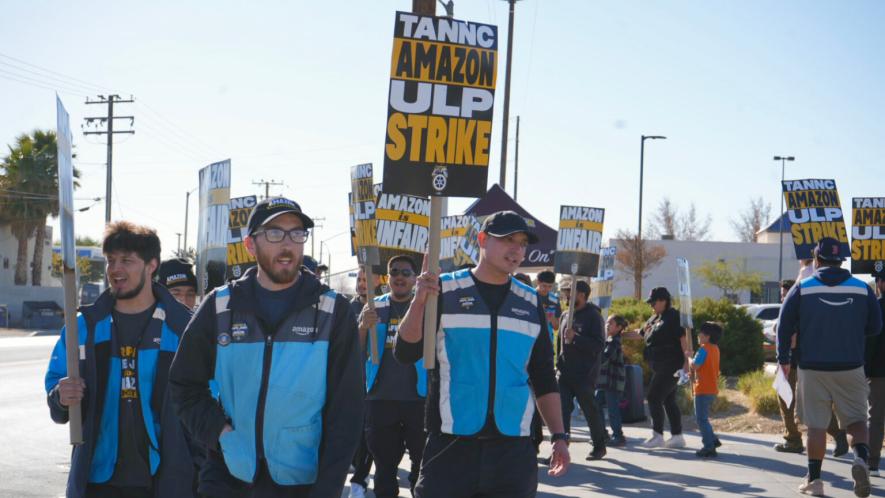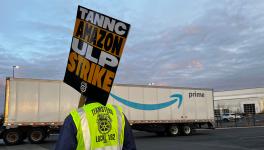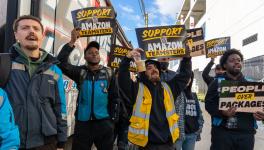Amazon Extracts Profit From Suffering of its Workers

Amazon drivers went out on strike before the pre-holiday season (Photo: Amazon Teamsters)
The week before Christmas, Amazon workers at facilities across the US, organized by the International Brotherhood of Teamsters, took on the world’s most profitable third party logistics corporation by walking off the job by the hundreds. Although this pre-holiday strike represented a minority of the Amazon workforce, it represented the largest strike against Amazon in US history.
Amazon’s profits keep breaking records, even within the context of a logistics industry that as a whole is experiencing a difficult freight market due to an oversupply of truck capacity. Amazon reported a record profit of USD 15.3 million in October of last year, surpassing Wall Street’s expectations. According to Transport Topics, Amazon has continued to expand its third-party logistics operations, unlike the vast majority of other industry giants. “More than three-quarters of the companies listed [in a list of top 100 logistics companies] saw their revenues decline in 2023 compared with the prior year as excess freight hauling capacity continued to tamp down freight rates,” writes Seth Clevenger for Transport Topics.
How is it possible that Amazon continues to break records amid an industry downturn? The ever-decreasing quality of life for its workers could provide some answers as to how Amazon, much like other corporations, extracts profit from human misery.
Poverty level wages
Despite Amazon being the most profitable logistics company, according to a University of Illinois study the majority of its US warehouse workers have been food insecure during a three-month period in 2024, almost half had experienced housing insecurity, and 56% have been unable to pay all of their bills within the same three-month period.
Rampant food and housing insecurity is no surprise when considering the poverty level wages Amazon pays its workers, even compared to other logistics companies. This has been highlighted by the Teamsters themselves, who have organized workers at UPS for almost 100 years. Most recently, UPS Teamsters won historic victories in a recent contract struggle, including a starting wage of USD 21 per hour. UPS Teamsters remain the highest paid delivery drivers in the country, with an average top rate of USD 49 per hour. Major benefits for UPS Teamsters include comprehensive healthcare coverage, even for part-time workers, as well as a pension and tuition assistance.
Meanwhile, Amazon DSP associates (which are the workers that can be seen delivering in Amazon-branded vans across the country) self-report average wages of USD 19.27. Amazon warehouse workers self-report an average wage of USD 18.02 per hour.
According to a 2023 study by the National Employment Law Project, warehouse workers in counties where Amazon operates earn 26% less than the average monthly earnings for other workers in those counties.
Research suggests that Amazon’s poverty-level wages not only negatively impacts Amazon workers, but implements a race to the bottom that worsens conditions for other workers as well. According to the same study by the National Employment Law Project, before Amazon’s establishment of fulfillment centers in the counties that now have them, wages for non-Amazon warehouse workers were close to the middle income for their respective areas. The research suggests that the establishment of Amazon facilities, with workers paid far less than middle income for their respective counties, had the effect of drawing down wages for warehouse workers outside of Amazon.
A pattern of injury and denial
A recent US Senate investigation illuminated the lengths that Amazon will go to in terms of allowing worker injury in the name of profit and productivity. A report by the Senate Committee on Health, Education, Labor, and Pensions, headed by Independent Senator Bernie Sanders, found that Amazon “prioritizes speed and profit over worker health and safety.”
According to the report, not only does Amazon manipulate “workplace injury data to portray its warehouses as safer than they actually are,” but Amazon forces its workers to repeat the same movements “hundreds and thousands of times each shift,” resulting in “extremely high rates of musculoskeletal disorders.”
Additionally, although Amazon has its own safety procedures, “the company’s required rates make those procedures nearly impossible to follow.” According to the report, “Workers report having to regularly bypass safety measures, such as properly using ladders or asking a teammate for help to lift a heavy item, to keep up with the company’s productivity requirements. As a result, workers are forced to choose between following safety procedures and risking discipline and potential termination for not moving fast enough.”
The injuries workers have incurred at Amazon’s warehouses and the corporation tries to extract as much productivity and profit as possible have taken a toll on workers. Workers report “chronic pain, loss of mobility, temporary and permanent disabilities, and diminished quality of life.”
Amazon is well aware of how its ruthless pursuit of maximum profits has hurt its workers, the Senate report revealed. According to the Senate committee, “Amazon has studied the connection between speed requirements and worker injuries for years, but it refuses to implement injury-reducing changes because of concerns those changes might reduce productivity.”
Not only have multiple Amazon-led research initiatives found connections between the company’s practices of speeding up work and forcing workers into repetitive work and worker injury (findings which Amazon later disregarded), but Amazon’s internal practices discourage workers from seeking medical care for their injuries. Workers also face challenges in obtaining proper accommodations for workplace-related injuries or disabilities, and terminated injured workers who are on approved medical leave. Staff at Amazon’s own on-site first aid centers (called “AMCARE”) delay workers’ referrals to outside healthcare providers—reducing the number of injuries Amazon reports to the federal government.
The same study from the University of Illinois also found that 60% of those taking unpaid time off because of pain or exhaustion report facing food insecurity, as opposed to 36% of those who do not take unpaid time off.
Keeping up the fight
Coming off the heels of the pre-holiday Amazon strike, workers are gearing up to keep up the fight against the logistics behemoth. According to the Teamsters, “The Amazon Teamsters movement will continue to grow bigger and stronger in 2025 at facilities all over the country and will not be stopped until union recognition and a Teamsters contract is won for all Amazon workers.” The union reported that by the end of 2024, the Teamsters had organized 25 units at Amazon composed of 10,000 workers in total.
Organizing at the most profitable logistics company poses a significant challenge, however. Amazon is infamous for its union-busting tactics, which during the pre-holiday picket line in Queens seemed to include deploying the NYPD to break up picket lines resulting in worker arrests, even going as far as flooding the picket line, an action which workers claim was deliberate.
Amazon also has an annual turnover of 150 percent, meaning that the number of workers leaving the company is even higher than the total number of employees, making long-term worker organizing a herculean task.
Get the latest reports & analysis with people's perspective on Protests, movements & deep analytical videos, discussions of the current affairs in your Telegram app. Subscribe to NewsClick's Telegram channel & get Real-Time updates on stories, as they get published on our website.
























